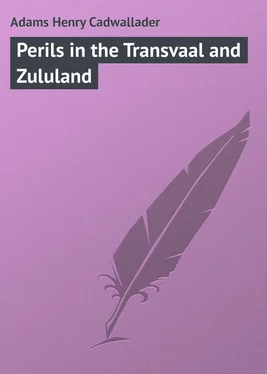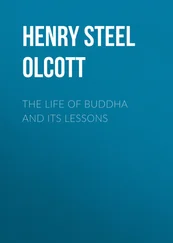Henry Adams - Perils in the Transvaal and Zululand
Здесь есть возможность читать онлайн «Henry Adams - Perils in the Transvaal and Zululand» — ознакомительный отрывок электронной книги совершенно бесплатно, а после прочтения отрывка купить полную версию. В некоторых случаях можно слушать аудио, скачать через торрент в формате fb2 и присутствует краткое содержание. Жанр: foreign_prose, foreign_children, на английском языке. Описание произведения, (предисловие) а так же отзывы посетителей доступны на портале библиотеки ЛибКат.
- Название:Perils in the Transvaal and Zululand
- Автор:
- Жанр:
- Год:неизвестен
- ISBN:нет данных
- Рейтинг книги:3 / 5. Голосов: 1
-
Избранное:Добавить в избранное
- Отзывы:
-
Ваша оценка:
- 60
- 1
- 2
- 3
- 4
- 5
Perils in the Transvaal and Zululand: краткое содержание, описание и аннотация
Предлагаем к чтению аннотацию, описание, краткое содержание или предисловие (зависит от того, что написал сам автор книги «Perils in the Transvaal and Zululand»). Если вы не нашли необходимую информацию о книге — напишите в комментариях, мы постараемся отыскать её.
Perils in the Transvaal and Zululand — читать онлайн ознакомительный отрывок
Ниже представлен текст книги, разбитый по страницам. Система сохранения места последней прочитанной страницы, позволяет с удобством читать онлайн бесплатно книгу «Perils in the Transvaal and Zululand», без необходимости каждый раз заново искать на чём Вы остановились. Поставьте закладку, и сможете в любой момент перейти на страницу, на которой закончили чтение.
Интервал:
Закладка:
“No doubt of that,” said George, smiling. “However, I am disposed to make all possible allowance for him under the circumstances you have mentioned; which are, I ought to add, but very imperfectly known to me. I suppose, as is generally the case, there are two versions of the story.”
“Probably there are,” said Mr Moritz, returning his smile, “and perhaps it is too much to expect that you should credit my version. However, whatever may come of it, I hope you and I will remain friends. I could never forget the service you have rendered me, and, indeed, Annchen also: for she tells me that she believes she is indebted to you for saving her life on the night of the attack.”
“I don’t know how that may be,” said George. “I did my best to protect her, certainly. But as you and her brother were not so close at hand as I was, to defend her, I do not know how I could possibly have done less. I hope we shall be allowed to take leave of her.”
“She will wish that too,” said Moritz, “but I am afraid her brother will not permit it. She has, indeed, charged me to give you her adieux, together with her regrets that she cannot speak them in person. But now you want my assistance in getting to your destination. Your best course, I think, will be to make the acquaintance of a Natal farmer, named Baylen; who, I have learned, means to set out in a few days for Horner’s Kraal, and will therefore pass very near, if he does not stop at, Umvalosa. He is a thriving man, and knows the country well. He is neither wholly English nor Dutch, his father having been an Englishman and his grandfather a Hollander, but his sympathies are mainly English. I will give you a letter to him. I would go with you to his son’s house, ‘Hakkluyt’s Kloof,’ where he now is, but time will not allow it, as Vander Heyden sets out in a few hours.”
George thanked him, and they cordially shook hands and parted. The two friends then walked out to Hakkluyt’s Kloof, and delivered Moritz’s letter; which at once secured a hearty welcome from the old man. He was a fine specimen of a colonial farmer, standing more than six feet high, and strongly, if somewhat heavily built. He introduced the young men first to his wife, a still comely matron of fifty, and his daughter Clara, a handsome girl of twenty, then to his sons, Stephen, the eldest, and owner of the Kloof, Walter, Wilhelm, and Ernest. They were all stout and sturdily-built young men, though hardly equalling their father’s height or breadth of shoulder. He readily agreed to convey the Englishmen and their baggage to Umvalosa, naming a very reasonable sum as their passage-money. He also invited them to take up their quarters at his farmhouse until the day of his departure came, an offer which the two lads were thankful to accept. George then went out to look at the waggons in which the journey was to be made – each of which, he found, would be drawn by no less than sixteen oxen. They were in construction not unlike an English waggon, only a good deal stronger and more solid. They were arranged not only for the conveyance of goods, but for the accommodation of travellers. At one end there were seats arranged on either side, and from the roof hammocks might be suspended, in which the females of the party might sleep; the men usually making their beds either under the waggons, or at the farther end. Two entire days were consumed in loading them. As George and Redgy were not to go the whole distance, their boxes were put in last, and then one day more was passed in careful examination of the cattle, to make sure they were all in sound condition. On the morning of the fourth day, however, they set out; the party consisting of the farmer, his wife and daughter and his three sons, three native servants, a boy, and the two young Englishmen. The first thing was to harness, or, as it is termed in that country, to inspan the cattle. This is a curious process for a stranger to witness. The oxen, which in a well-trained team are fully as well experienced in the operation as their masters, are driven close up to the wheel of the waggon, with their heads towards it. Then the waggon driver calls each ox by its name, which it knows as well as any English dog knows his, and the animal bends forward to allow the yoke to be put upon its neck. Then they are arranged in a double line – eight couple, one behind the other, a Kaffir lad, called the fore-louper, leading the way. He brandishes in his hand a huge whip of cameleopard’s hide, which he delivers with terrific effect on the shoulders or back of the unhappy animals, generally towards the close of the journey, when the team are becoming weary, or, at all events, lazy.
The farmer and one of his sons accompanied the waggon on horseback, while the rest of the party walked by the side, or took a few hours’ siesta in the waggons. Farmer Baylen proposed to George to ride the first part of the journey in his and his son’s company, and the latter gladly accepted the offer. He was greatly struck with the beauty of the scenery in the neighbourhood of Durban. The journey for the first two days lay over Cowie’s Hill, which rises to a considerable height, affording a wide prospect of the sea-coast, with its rich line of woods; while inland, the country for a considerable distance presents a succession of elevated ridges, extending as far as the Umkomanzi river. The road itself was in the highest degree picturesque. It was November, the May of the Southern Hemisphere. Every now and then the waggons would enter upon a thick undergrowth of shrubs, ploughing their way, as it were, through an inland sea; the fragrance and beauty of the shrubs far exceeding anything that an English landscape presents. When a few miles had been accomplished, the oxen were outspanned, and allowed to graze, while the men took their mid-day meal, and afterwards smoked their pipes, under the shelter of some fragrant shrubs. Just as they reached the first halting-place, George discerned in the distance some singular-looking circular erections, which, the farmer informed him, were a native village; and finding that George was anxious to see it, offered to ride up and make an examination of it. The offer was gladly accepted, and after a short canter the kraal was reached. It was situated on one of the slopes above a rapid stream, and was built after the design usual among the Kaffirs. There were two circular enclosures, one inside the other, the whole being protected by a strong palisade. The outer circle is for the Kaffirs themselves, the inner one for the cattle. As these latter constitute the wealth of the villagers, they are careful to secure them against theft or violence, and by this arrangement they could only be seized after all the resistance the men could offer had been overcome. Each hut is circular in shape, and consists of a framework, constructed of long poles, driven into the ground, and bent towards the top, so as to meet at one point in the centre. Similar poles are laid horizontally at intervals one above another, and secured to the uprights by strips of fibre, so that the whole structure resembles a huge circular crate. The portion which forms the roof is covered with grass pegged down and secured to the poles, something after the way in which ricks are thatched in England. The floor usually consists of clay, when it can be found in the neighbourhood, levelled and beaten hard. It is sometimes even polished, by being rubbed over with a flat stone. There is a circular elevation in the centre of the hut similarly formed, which serves as a fireplace, but there is nothing resembling a chimney, the smoke escaping, as used to be the case in the dwellings of the ancient Britons, through the framework above. There is generally a door formed of wattle-work, which can be closed in inclement weather, and sometimes a kind of screen of similar material can be placed to windward of the fire, when the weather is unusually severe. George was struck with the fine proportions and intelligent faces of the men, many of them exhibiting muscular, stalwart frames and expressive features, which a Greek sculptor might not have disdained to copy. The women, though some of them were not ungraceful in figure, were not nearly equal, either in personal beauty or intelligence, to their male companions. Their features were, indeed, altogether too flat to satisfy the European idea of beauty, a fault which was not observable among the men. On George’s remarking this disparity of the sexes to the farmer, he answered it was no doubt caused by the severe and incessant labour imposed upon the women, for which nature had not designed them.
Читать дальшеИнтервал:
Закладка:
Похожие книги на «Perils in the Transvaal and Zululand»
Представляем Вашему вниманию похожие книги на «Perils in the Transvaal and Zululand» списком для выбора. Мы отобрали схожую по названию и смыслу литературу в надежде предоставить читателям больше вариантов отыскать новые, интересные, ещё непрочитанные произведения.
Обсуждение, отзывы о книге «Perils in the Transvaal and Zululand» и просто собственные мнения читателей. Оставьте ваши комментарии, напишите, что Вы думаете о произведении, его смысле или главных героях. Укажите что конкретно понравилось, а что нет, и почему Вы так считаете.












![Edward Ellis - Adrift on the Pacific - A Boys [sic] Story of the Sea and its Perils](/books/753342/edward-ellis-adrift-on-the-pacific-a-boys-sic-s-thumb.webp)